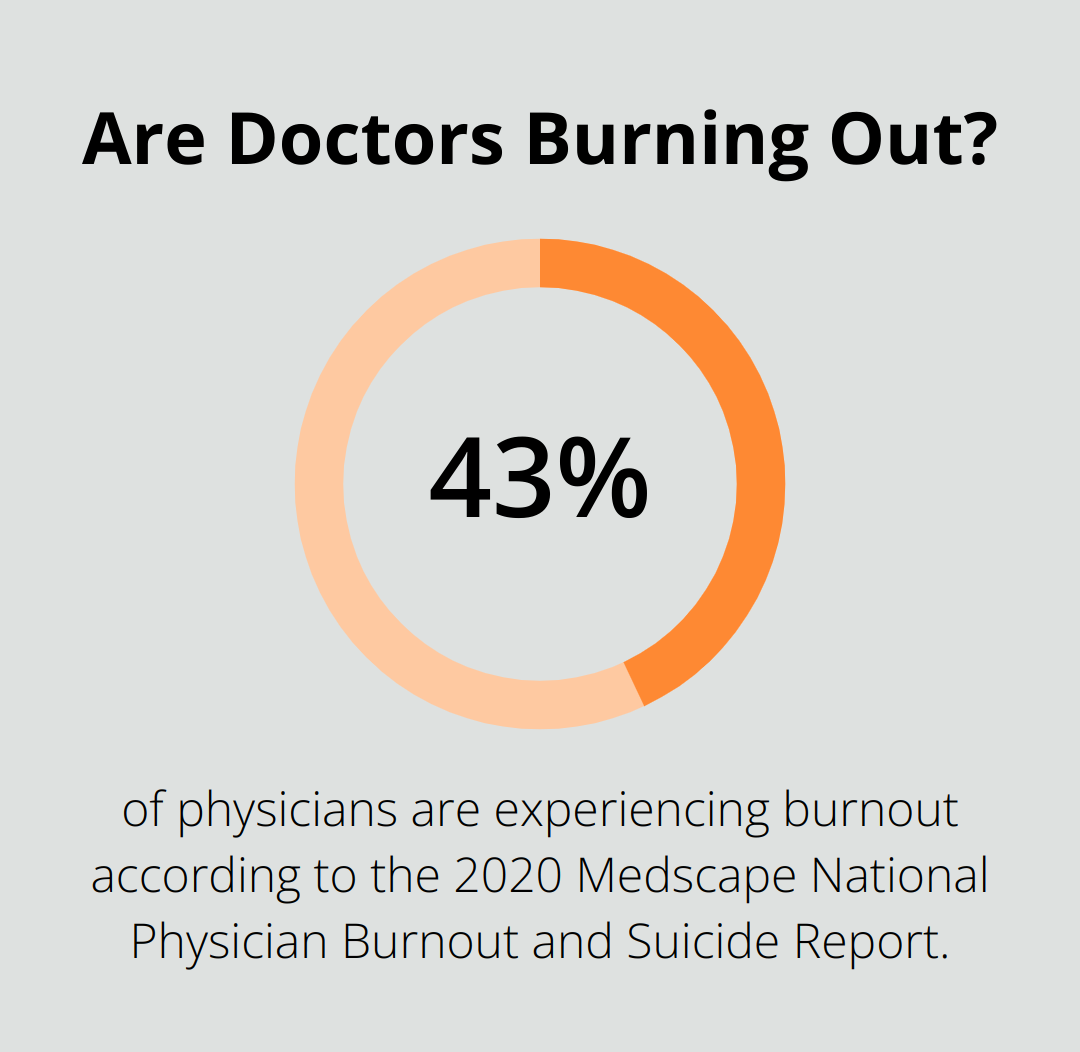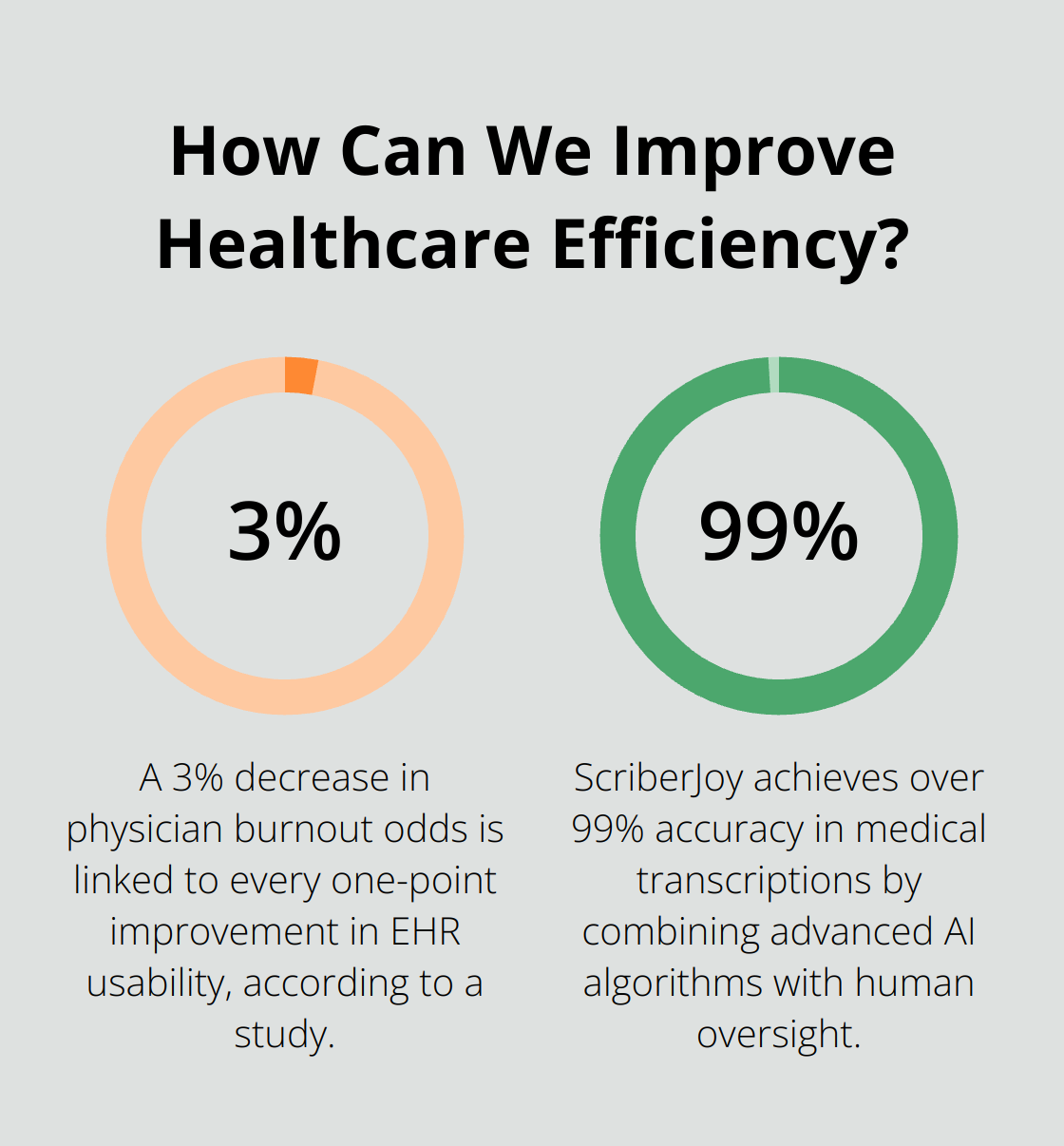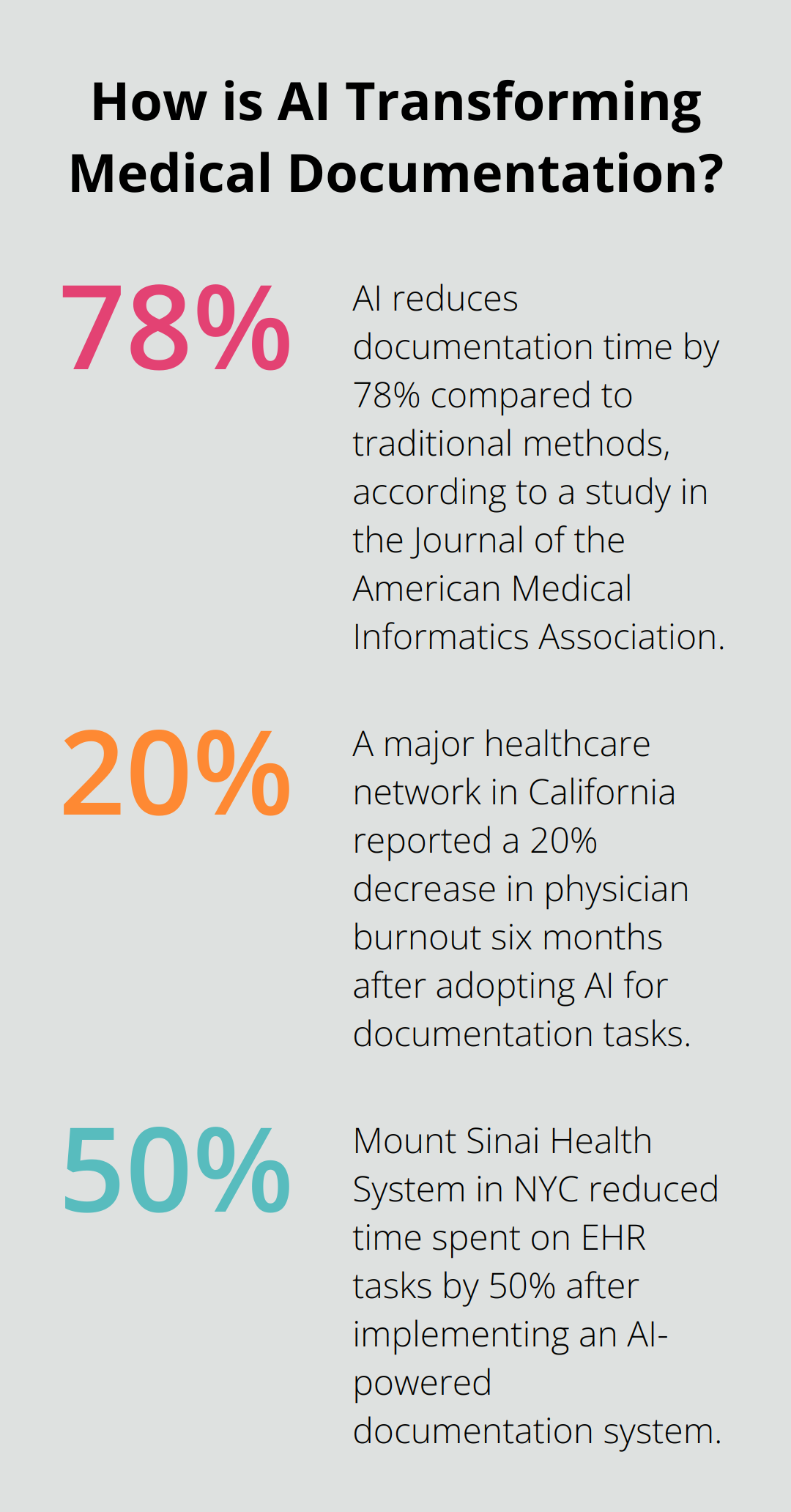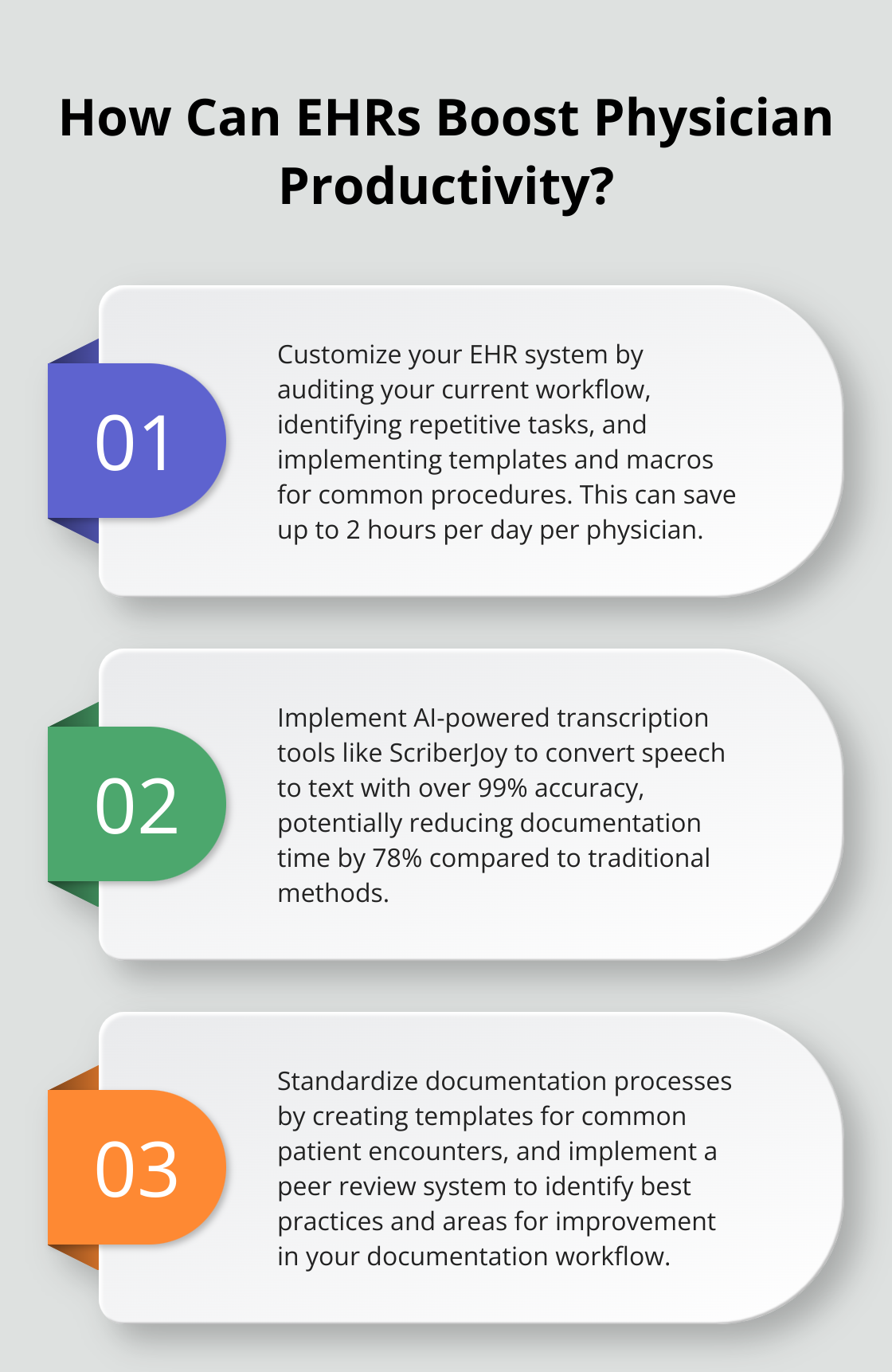Burnout among physicians—it’s a big deal, folks, and it’s gripping healthcare systems all over the globe. Why? Documentation overload, that’s why. It’s like paperwork’s out to get the doctors… and trust me, patients feel the pain too.
Enter ScriberJoy—we get it. This is an urgent issue, and we’re on it like white on rice. Today, let’s dive into some no-nonsense strategies and the latest, greatest solutions to make documentation a breeze (or, you know, at least less of a hurricane) and give docs some much-needed relief.
The Hidden Costs of Documentation Overload
The Burnout Epidemic
We’re looking at a crisis, folks-physician burnout is off the charts. The 2020 Medscape National Physician Burnout and Suicide Report says we’re sitting at a burnout rate of around 43%. Not just a blip on the radar-this is an epidemic wreaking havoc on a substantial chunk of our medical professionals. And the villain in the room? You guessed it, endless paperwork. The stats are screaming at us: our medical pros are drowning in documentation.
The Documentation Time Sink
Let’s talk about the time drain-it’s a black hole. Physicians are logging a huge number of hours on EHR tasks, even outside their typical office time. During those patient visits you envision should be all about…well, patients? The real story is healthcare professionals are stuck in this crazy loop of documentation over patient care. It’s a circus of priorities where jotting down notes is stealing the spotlight from actually looking after people.
The Ripple Effect on Healthcare Organizations
Burnout’s ripple effect-it’s not just a personal crisis; it’s organizational chaos. The burnout stress storm results in high turnover rates, throwing a wrench in healthcare’s quality gears. And the economic hit? Oh boy, it’s steep-just look at the soaring costs related to burnout-driven turnover and shortened clinical hours in the US healthcare machine.

But here’s the kicker-it’s not just a numbers game. Burnout’s harmful cocktail messes with the quality of patient care, cranks up the likelihood of medical mishaps, and chips away at the trust and relationship between doctors and patients. Drowning in documentation crushes physicians’ brainpower for critical thinking and that all-important empathy.
The Patient Impact
Who takes the hardest hit from physician burnout? The very people who need care-patients. When doctors are chained to paperwork more than they’re seeing patients, you end up with:
- Wham-bam-thank-you-ma’am appointments
- Care that feels about as personal as a robo-call
- Longer waits
- Oopsies, aka misdiagnoses
All these elements brew a storm that drags down the patient experience and worsens health outcomes.
The Path Forward
The healthcare sector needs a reality check pronto. Fixing the documentation maze isn’t just a checkbox tick-it’s a rescue mission for the heart of healthcare. Easing off the admin throttle could let docs hit refresh, reignite their love for healing, and deliver top-tier care again.
Up next, we’re diving into real tactics to declutter documentation chaos. With the latest tech (like shout-out to ScriberJoy), we’ll see how the landscape of medical transcribing gets a seismic shift. The antidote for physician burnout? It begins with slick, savvy documentation-and the moment to act is now.
Streamlining Documentation: Practical Solutions
The documentation burden on physicians is a beast – but it’s not unbeatable. This chapter zooms in on actionable strategies that can make a real dent in your daily grind.
Revamp EHR Systems for Efficiency
Electronic Health Record (EHR) systems tend to frustrate physicians. I mean, who hasn’t yelled at their screen? A study shows that every one-point bump in EHR usability links to a 3% cut in physician burnout odds. The golden ticket? Customization and sharp design.

Kick things off with an audit of your current EHR workflow. Spot those pesky repetitive tasks and hunt for automation gems. Many EHR systems come packed with template and macro options. These can slash your documentation time for run-of-the-mill procedures or diagnoses. Imagine a pediatrician wielding a well-child visit template – pre-loaded with age-specific questions and exam bits.
Team up with your IT squad or EHR vendor to smooth out the user interface. Small tweaks (like trimming the number of clicks needed to get stuff done) can save hours in the long run. Some practices shout about saving up to 2 hours a day per physician – just by shaking up their EHR setups.
Leverage Voice Recognition and AI Transcription
Voice recognition tech… it’s leaped forward. And why not put it to use? A study stacked up the efficiency and safety of using SR (speech recognition) for clinical documentation against the old-school ways.
Dip your toes in slowly. Start with basic notes or letters, and as you ease in, tackle trickier documentation. The learning curve? Barely a blip, but the payoff is big bucks.
Standardize Documentation Processes
Standardization isn’t code for boring; it’s code for a slick, cohesive documentation process across your practice. The Agency for Healthcare Research and Quality says standardized processes chop errors and boost patient outcomes.
Zero in on your most common patient encounters. Cook up standardized templates for these visits, make sure they nail all the essentials without the fluff. Keep these templates fresh – with regular checkups and updates thanks to user feedback and new needs.
Think about rolling out a peer review system for documentation. It’s not a witch hunt; it’s about spotting best practices and where you can dial things up a notch. It’s the spirit of continuous improvement and shared learning.
Embrace AI-Powered Solutions
AI in medical documentation? It’s a whole new ballgame. AI-powered transcription (think ScriberJoy) packs speed and precision. They can whip up transcriptions of medical notes in a flash, freeing up physicians to focus on patient interactions rather than scribbles.
ScriberJoy blends cutting-edge AI algorithms with human oversight to nail over 99% accuracy in medical transcriptions. This combo ensures the speed and accuracy gains aren’t just pipe dreams, but the real deal – vital in medical documentation.
Next up, the chapter dives into how these AI-powered wonders are shaking up the documentation scene, offering a glimpse into the future of medical record-keeping with the huge potential to ease physician burnout.
AI Revolutionizes Medical Documentation
The AI Advantage in Transcription
So, here’s the deal-AI is shaking up medical documentation like nobody’s business. This stuff is a godsend for exhausted doctors, making waves in clinics from coast to coast.
AI-powered transcription tools convert speech to text with jaw-dropping accuracy. Seriously, though, human transcriptions are up to 99% more on point than the machine version. But hey, according to a study in the Journal of the American Medical Informatics Association, AI slashes documentation time by a whopping 78% compared to the old-school methods.
Boosting Efficiency and Patient Care
But wait, there’s more! It’s not just about saving time. Doctors using these AI tools are clawing back up to an hour a day from their keyboards. What does that mean? More face time with patients, less burnout-win-win.

These AI systems? They’re picking up patterns, suggesting diagnoses faster than you can say “thermometer.” They streamline documenting and ramp up patient care quality by serving up relevant info at lightning speed.
Real-World Success Stories
And we’re not just talking theory here-real-world action is where it counts. Mount Sinai Health System in NYC jumped on an AI-powered documentation setup and-you guessed it-slashed time spent on EHR tasks by 50% and cranked physician satisfaction scores up by 70%.
California’s major healthcare network? They’ve got tales to tell too. A 20% plunge in physician burnout just six months post-AI adoption, thanks to that sweet, sweet relief from documentation drudgery.
The Role of Human Oversight
But here’s the twist-AI’s fast, but not flawless. Humans are still in the loop, checking the AI’s work for accuracy and keeping things contextual. This blend of machine speed and human savvy (cue solutions like ScriberJoy) makes for rock-solid medical records.
Future Prospects of AI in Healthcare Documentation
Onward and upward, right? With AI in healthcare documentation, the future looks something like this:
- Natural language processing that understands even the most convoluted medical lingo
- Syncing with wearables for real-time patient data feeds
- Predictive analytics ready to jump in for diagnosis and treatment planning
Bottom line-less paperwork for docs, more time to actually care for people. What’s not to love?
Final Thoughts
We’re knee-deep in the physician burnout crisis, and healthcare organizations need to step up-yesterday. Efficient documentation solutions, especially the AI-wizards like ScriberJoy, are key in this mess. They’re not just time-savers; they let doctors do what they do best-actually connect with their patients.

By putting efficient documentation solutions at the forefront, both healthcare providers and patients win big. Docs who aren’t buried in paperwork can actually focus on patient care-pretty simple math leads to better health outcomes and happier faces all around. Investing in this tech isn’t just smart-it’s putting chips on the well-being of our healthcare heroes and upping the ante on the care they dish out.
It’s time for healthcare orgs to take a long, hard look at these innovative solutions to create environments where not only physicians thrive but patients walk away happier too. With game-changers like ScriberJoy at our fingertips, we’ve got all the tools to tackle these challenges head-on and rewrite the healthcare narrative. Time’s ticking-let’s change the script on medical documentation and take down physician burnout.

Leave a Reply
You must be logged in to post a comment.